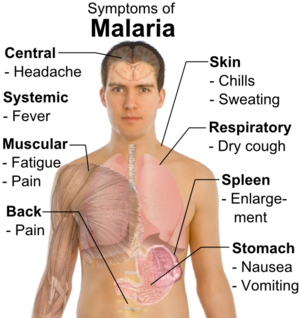Plasmodium falciparum in Cambodia
Introduction to Malaria
Malaria is fatal disease that infects about 515 million people worldwide and kills nearly a million people annually (1). Malaria is widespread in mostly tropical and subtropical countries because of their conditions allow the Anopheles mosquitoes to thrive.
Malaria infected individuals have symptoms such as fever, abdominal pain, chills, headaches, nausea, diarrhea, vomiting which can appear after couple of days or weeks after the infection. Also, very often malaria can lead to severe anemia, seizures, kidney failure, confusion and death if not treated on time (5).
The parasite initially enters the liver, where it multiplies and then infects the red blood cells. Here parasites still continue to multiply until eventually the red blood cells burst and the parasite appears in the plasma. Now, the parasites are free in the plasma and will infect any mosquito that bites and feeds on the host’s blood. Once the parasites enter the mosquito, they are also found in its saliva and are ready to be transferred to another individual and repeats the cycle after biting another host.
As a result of its devastating effects on the human population, many organizations (Gates Foundation) and countries (Global Fund) have banded together to find preventative measures and treatments for this global epidemic.
Description of Malaria
In Cambodia, the specific species (Anopheles dirus, A. minimus, and A. sundaicus) transmit the malaria-causing parasites (Plasmodium falciparum and P. vivax) to the host during feeding with the bite, transmitting the parasite through their saliva.
The number of infected people observed in Cambodia each year exceeds more than a million out of which about 10-15% die (5). Victims of malaria are mostly children, infants, and pregnant women because of their weaker immune system (3). Forest inhabitants, border workers and migrants are also in high risk in getting the disease because of their increased exposure to mosquito vectors. Due to global warming, the increasing temperatures, humidity, and rains may all favor the spread of malaria as mosquito habitats spread (4).
Description of the Plasmodium falciparum
Transmission of disease
How is it transmitted? Is there a vector (animal/insect)?
Prevention
Why is this disease a problem in Cambodia?
What is being done to address this problem
Include anything being done by the local government or groups as well as efforts by non-local groups.
What else could be done to address this problem
Are there solutions that could be successful but haven't been implemented due to political or economic reasons? Are there successful efforts in other countries? Are there reasons why these efforts may or may not be successful in the country you've focused on? etc. etc.
References
1. “Genome of Parasite that Causes Relapsing Malaria Decoded.” 2009. ScienceDaily. 9 Oct. 2008.
2. Pierce, Susan K., Miller, Louis H. World Malaria Day 2009: What Malaria Knows about the Immune System that Immunologists Still Do Not. 2009. The Journal of Immunology. 5 March, 2009.
3. “Drug-Resistant Malaria Has Emerged in Cambodia.” 2009. Science Daily. 13 Aug. 2009.
4. “Is Global Warming Likely to Cause an Increase Incidence of Malaria?” 2009. Libyan Journal of Medicine. 13 Feb. 2009.
5. "Fewer Malaria Cases in Cambodia.” 2009. Population Reference Bureau. Dec. 2002.
6. "Epidemiological Profile of Cambodia" World Malaria Report 2008. Geneva : World Health Organization , ©2008. p.51-54.
Edited by [Betsy Chiem, Ben Cho, Chuong Do, Katherina Leu, Albert Luong and Lusine Minasyan], students of Rachel Larsen

